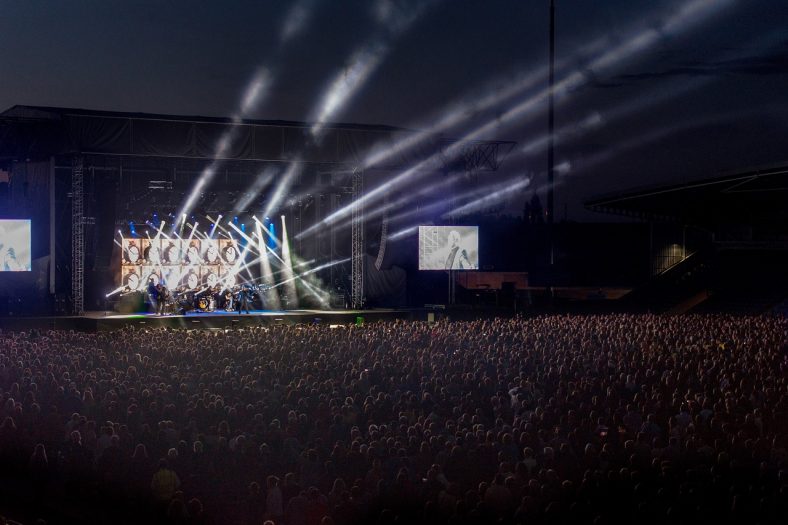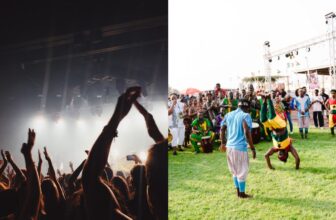35 Types of Music Genres and Styles (With Examples)

Music is like a melting pot of genres. There are countless genres and sub-genres, encompassing rock, jazz, rap, and so much more. Let’s explore the world of sounds and styles, as we delve into the top 35 types of music.
Let’s get right into it!
Contents
1. Pop
Pop music is an eclectic genre that features catchy melodies, and simple chord progressions, and usually deals with themes of love and relationships. This genre is defined by its accessibility and broad appeal.
Its production often involves a glossy, high-fidelity sound that is both polished and meticulously crafted. Pop music is known for its ability to evolve, absorbing elements from various other genres like hip-hop and rock to stay fresh and relevant.
Sub-genres: Electro pop, teen pop, power pop, pop-rock, and many more.
Popular artists:
- Taylor Swift
- Ariana Grande
- Billie Eilish
2. Rock
Rock music originated from rock and roll and quickly became a force of its own. It’s known for strong, driving rhythms, amplified instruments, and emotive lyrics. Rock music has always been associated with rebellion and social commentary, and it’s often lauded for its raw, unfiltered sound.
Derived from several popular genres at the time like blues, country, folk, jazz, and other styles, rock culminated in a widely accepted and hugely popular genre that took the world by storm. Rock incorporates electric instruments like the electric guitar, bass, keyboard, and acoustic drums.
Sub-genres: alternative rock, indie rock, hard rock, and punk rock, among others.
Popular artists:
- The Rolling Stones
- U2
- Foo Fighters
3. Rap
Rap is a genre centered around rhythm and rhymes. Often combined with hip-hop, it’s known for its powerful lyrical content that often discusses societal issues, personal experiences, and storytelling.
It’s unique in that the musical focus is on the rhythm and flow of the spoken words, making the vocals the most important aspect of the genre. This genre has taken the world by storm with a massive following behind it and names like Eminem, Kendrick Lamar, and Tupac, who have transcended the genre and brought it to the world.
Sub-genres: gangsta rap, trap, mumble rap, and conscious rap, among others.
Popular artists:
- Kendrick Lamar
- Drake
- Eminem
4. Jazz
Jazz is often characterized by its swing rhythms, improvisation, and complex harmonies. It’s a highly expressive genre, allowing musicians to inject their own style and emotion into their performances. This creativity and spontaneity make every jazz performance a unique experience.
While not universally embraced, jazz stands as a groundbreaking genre, showcasing virtuosic artists who have pushed the boundaries of their instruments. These trailblazers have not merely made music, but masterfully pushed the envelope of what is possible with a musical instrument, rewriting the lexicon of sound and performance, and thus, catapulting jazz into an unparalleled realm of artistic expression.
Sub-genres: bebop, cool jazz, smooth jazz, and free jazz, among others.
Popular artists:
- Miles Davis
- Ella Fitzgerald
- Herbie Hancock
5. Blues
Blues music is known for its emotive expression of struggle and triumph. This genre is characterized by its use of the “blues scale”, repetitive chord progressions, and soulful, often melancholic lyrics.
Its roots in African-American communities have helped shape other genres of music such as rock and jazz. Despite that, blues remains a genre that can stand on its own with numerous popular tones and widely-regarded artists.
Sub-genres: delta blues, Chicago blues, and blues rock, among others.
Popular artists:
- B.B. King
- Muddy Waters
- Eric Clapton
6. Folk
Folk music is often rooted in tradition, telling the stories and experiences of a people or culture. Characterized by acoustic instruments and simple melodies, it places a strong emphasis on lyrics and storytelling.
Folk music’s authenticity and connection to cultural heritage give it a timeless appeal. Deeply rooted and associated with people’s folklore, folk music is battle-tested and has evolved into a number of subgenres that are widely accepted today.
Sub-genres: contemporary folk, folk rock, and indie folk, among others.
Popular artists:
- Bob Dylan
- Joan Baez
- Mumford & Sons
7. Metal
Metal music is known for its aggressive and intense sound, often featuring distorted guitars, heavy drumming, and powerful vocals. Despite its sometimes extreme nature, it has a large, dedicated fan base due to its raw energy and technical complexity.
The genre derived from rock music and its various subgenres like blues rock, psychedelic rock, and acid rock, among other styles, to form its own culture and stand on its feet. Highly prominent today, metal music has a substantial following and is one of the more popular music genres out there.
Sub-genres: heavy metal, death metal, and black metal, among others.
Popular artists:
- Metallica
- Iron Maiden
- Slayer
8. Country
Country music is rooted in rural American folk and Western music. Known for its emotive storytelling, country music often features themes of love, heartbreak, and everyday life. It’s characterized by its distinctive twang, making use of instruments like the guitar, piano, banjo, and fiddle.
Country music is still highly regarded today with young artists like Taylor Swift keeping the genre at the top with captivating and interesting songs. A genre known for its ballads, Country music is still at the top of the music tree.
Sub-genres: country pop, outlaw country, and bluegrass, among others.
Popular artists:
- Johnny Cash
- Dolly Parton
- Blake Shelton
9. Classical
Classical music is a vast genre that encompasses music from the Middle Ages to the present day. Known for its complexity and rich harmonies, classical music requires a high level of skill and understanding to perform.
It’s often seen as the foundation of many other music genres. Classical music is characterized by its intricate compositions, emotional depth, and rich orchestration and despite being around for a very long time, some classical compositions are still widely regarded today.
Sub-genres: baroque, romantic, and modern classical, among others.
Popular artists/composers:
- Ludwig van Beethoven
- Wolfgang Amadeus Mozart
- Yo-Yo Ma
10. Reggae
Reggae music is most associated with Jamaica and is characterized by its offbeat rhythms and relaxed tempo. Often featuring themes of peace, love, and social commentary, it has a distinct sound that’s both danceable and thought-provoking.
Originating in the late 60s, Reggae was highly influenced by American jazz and rhythm and blues and it traveled worldwide because of artists like Bob Marley, Peter Tosh, and others.
Sub-genres: roots reggae, dancehall, and reggae fusion, among others.
Popular artists:
- Bob Marley
- Peter Tosh
- Sean Paul
11. Punk
Punk music is characterized by its raw sound, often featuring short songs with fast, hard-edged melodies and stripped-down instrumentation. It’s also known for its rebellious spirit and countercultural lyrics, making it a powerful medium for social and political commentary.
Punk supports the DIY mentality; many bands self-produce recordings and distribute them through independent record companies as they embody the anti-establishment mindset.
Sub-genres: punk rock, pop punk, and hardcore punk, among others.
Popular artists:
- The Ramones
- Green Day
- The Sex Pistols
12. Techno
Techno is a genre of electronic dance music that’s characterized by its repetitive beats and synthesized sounds. Originating from Detroit in the 1980s, it’s known for its futuristic themes and is often associated with rave culture.
Techno often uses a tempo between 120 and 150 BPM (beats per minute) which is a general and unspoken rule of thumb within the genre. Also, it incorporates electronic instruments such as drum machines, sequencers, and synthesizers.
Sub-genres: minimal techno, dub techno, and acid techno, among others.
Popular artists:
- Richie Hawtin
- Carl Cox
- Jeff Mills
13. Trance
Trance is another form of electronic dance music. It’s characterized by its fast tempo, repetitive melodic phrases, and build-ups and breakdowns that create a hypnotic, euphoric feel.
Its emphasis on melody and atmosphere sets it apart from other electronic genres. Much like techno music, Trance usually varies between 135 and 150 beats per minute with repeating melodic phrases.
Sub-genres: progressive trance, psytrance, and uplifting trance, among others.
Popular artists:
- Armin van Buuren
- Paul van Dyk
- Above & Beyond
14. EDM
EDM, or Electronic Dance Music, is a broad term that encompasses various sub-genres like house, techno, and dubstep. It’s known for its catchy melodies, synthesized sounds, and heavy use of samples and loops.
EDM has become synonymous with party culture due to its energetic and danceable tunes. It often includes a catchy chorus performed by guest artists, hard-hitting drum patterns, and a big moment of tension followed by a powerful drop.
Sub-genres: big room EDM, tropical house, and future bass, among others.
Popular artists:
- Calvin Harris
- David Guetta
- Martin Garrix
15. Dubstep
Dubstep is a genre of electronic music that originated in South London. It’s characterized by its heavy basslines, sparse rhythms, and emphasis on sub-bass frequencies. The distinctive “wobble” sound and syncopated rhythms give dubstep its unique, energetic feel.
The genre was highly popularized by artists like Skrillex and Zomboy. It often incorporates elements of broken beat, grime, and drum and bass with syncopated rhythmic patterns that give it a unique feel.
Sub-genres: brostep, post-dubstep, and melodic dubstep, among others.
Popular artists:
- Skrillex
- Burial
- Zomboy
16. Drum and Bass
Drum and bass is a fast-paced genre of electronic music characterized by breakbeats, heavy bass, and sub-bass lines. Its high-tempo rhythms and intricate drum patterns make it a favorite among dance music enthusiasts.
Drum and bass is often within the 165 to 185 beats per minute range which is pretty fast. Originally inspired by Jamaican dub and reggae, Drum and bass or DnB now features complex syncopation and has spawned a whole dance culture that is highly addictive and fun.
Sub-genres: liquid drum and bass, Neurofunk, and jump-up, among others.
Popular artists:
- Goldie
- Pendulum
- Netsky
17. R&B
R&B, or Rhythm and Blues, is a genre known for its soulful vocals and steady, groovy rhythms. It often features themes of love, relationships, and personal experiences.
R&B’s smooth and emotive style has a broad appeal and has greatly influenced different types of music genres like pop and hip-hop. Popular artists like Beyonce and Alicia Keys have kept the genre at the top of the music industry and belted out songs that are considered timeless.
Sub-genres: contemporary R&B, soul, and neo-soul, among others.
Popular artists:
- Beyoncé
- Usher
- Alicia Keys
18. Indie
Indie music, short for “independent,” is characterized by its deviation from mainstream music norms. It often features unconventional song structures, experimental sounds, and introspective lyrics.
The indie ethos of valuing creativity over commercial success gives this genre a unique and diverse sound. Much like punk, Indie music also favors the DIY approach to recording and publishing.
Sub-genres: indie rock, indie pop, and lo-fi, among others.
Popular artists:
- The Strokes
- Arctic Monkeys
- Tame Impala
19. Trap
Trap music is a subgenre of hip-hop music, characterized by its dark, ominous beats and aggressive lyrical content. It’s known for its use of 808 kick drums, fast hi-hats, and synthesized melodies. Trap’s gritty sound and streetwise lyrics have gained it a large, dedicated fanbase.
Sub-genres: drill, emo trap, and Latin trap, among others.
Popular artists:
- Migos
- Future
- Young Thug
20. Instrumental
Instrumental music is a genre that emphasizes musical instruments over vocals. It spans a wide range of styles, from classical symphonies to jazz improvisations to electronic compositions. Instrumental music’s focus on melody and harmony makes it a favorite for background music or studying.
Sub-genres: instrumental rock, instrumental hip hop, and ambient, among others.
Popular artists:
- Explosions in the Sky
- Chet Atkins
- Nils Frahm
Additional Genres
21. Bossa Nova
Known for its smooth, relaxed sound, Bossa Nova is a Brazilian music style that fuses samba and jazz. Artists: Antônio Carlos Jobim, João Gilberto.
22. Disco
Known for its catchy beats and flamboyant style, Disco dominated the music scene in the 70s. Artists: Bee Gees, Donna Summer.
23. Ska
Ska is a genre that combines elements of Caribbean mento and calypso with American jazz and rhythm and blues. Artists: The Specials, Madness.
24. World
World music incorporates styles and sounds from around the globe, creating a rich tapestry of musical diversity. Artists: Angelique Kidjo, Manu Chao.
25. Latin
Known for its upbeat rhythms and passionate vocals, Latin music includes styles like salsa, reggaeton, and bachata. Artists: Shakira, Marc Anthony.
26. Opera
Opera is a genre that combines music with theatrical performance. Artists: Luciano Pavarotti, Maria Callas.
27. Shoegaze
Shoegaze is known for its heavy use of effects pedals, creating a wall-of-sound backdrop for the vocals. Artists: My Bloody Valentine, Slowdive.
28. Funk
Funk is known for its groovy basslines and rhythmic, danceable beats. Artists: James Brown, Parliament-Funkadelic.
29. Swing
A form of jazz music known for its upbeat tempo and rhythmic “swing”. Artists: Duke Ellington, Benny Goodman.
30. Grunge
A subgenre of rock that emerged in the mid-1980s, Grunge is characterized by its distorted guitars and introspective lyrics. Artists: Nirvana, Pearl Jam.
31. Gospel
A genre deeply rooted in the Christian faith, Gospel music is known for its fervent vocals and emotive performances. Artists: Mahalia Jackson, Kirk Franklin.
32. Bluegrass
A form of American roots music, Bluegrass is characterized by its acoustic stringed instruments and complex harmonies. Artists: Bill Monroe, Alison Krauss.
33. Soul
Soul music is known for its deep emotional resonance and incorporation of gospel, rhythm and blues. Artists: Aretha Franklin, Sam Cooke.
34. New Wave
A genre that emerged in the late 70s, New Wave combined the energy of punk rock with electronic music and pop sensibilities. Artists: The Police, Blondie.
35. Industrial
Industrial music is known for its abrasive and often harsh soundscapes, utilizing non-traditional instruments like scrap metal and noise generators. Artists: Nine Inch Nails, Ministry.
Conclusion
From the lush melodies of Classical music to the gritty beats of Trap, the world of music is a vast, vibrant landscape of sound. It’s a testament to human creativity and expression, encapsulating our emotions, stories, and experiences in a language that transcends barriers. No matter your taste, there’s a genre out there that resonates with you, and hopefully, this guide has helped you explore the rich diversity of music.






All Music is the same consisting of scales cords approach,etc its no need to label music its either good or bad either the person can play or they can not either they can sing or they can not. ( as the saying goes if you cant run with the big dogs stay on the porch). I listen to all kinds I personally like musicians who are constantly trying new things because with music you never stop learning some musicians grow old before there time because their music sounds the same.( this is just my opinion its not worth much have a good day! )
Genre is a very subjective thing but the problem with the ‘only 2 types good and bad’ is that it is even more subjective than genre. In truth most types of popular music are closely related, containing similar chords beats and often samples. Pop will often have a section of rap or a rock guitar. Many hip hop and electronic songs use latin beats, horn riffs (sampled or real) etc etc. Genre is often no more than a marketing tool so that commercial interests can determine a target audience.